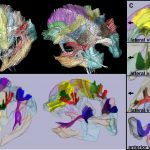Computational Anatomy
Computational Anatomy is an interdisciplinary area of research focused on quantitative analysis of variability in biological shapes. Mathematicians, statisticians, neuroanatomists and clinicians work together to examine questions such as:
- how different is the shape of the hippocampus in the adolescent female with a risk for depression?
- how can schizophrenia affect thinning in the planum temporale?
- how can demyelination affect connectivity between structures in the brain?
- how do we limit the amount of harmful radiation from CT scans a child is exposed to?
- which part of the left ventricle of the heart is affected in sudden cardiac death?
Computational Anatomy compares anatomical shapes using smooth invertible non-rigid mappings called diffeomorphisms. This was recognized in 1917 by the biologist D’Arcy Wentworth Thompson, who wrote in his famous book, On Growth and Form, “In a very large part of morphology, our essential task lies in the comparison of related forms rather in the precise definition of each; … This process of comparison, of recognizing in one form a definite permutation or deformation of another, ….is the Methods of Coordinates, on which is based the `Theory of Transformations’.”
It wasn’t until the early 2000s that the genesis of the Grenander’s Metric Pattern Theory resulted in the development of the “Large Deformation Diffeomorphic Metric Mapping” algorithm that now underpins much of our research in Computational Anatomy. ICM Computational Anatomy research is focused on identifying those differences in brain shape and connectivity that characterize neuro-psychiatric and neuro-developmental diseases, shape and motion changes in the heart that are signatures of heart disease, and tumor shape changes that characterize progression of cancer.



